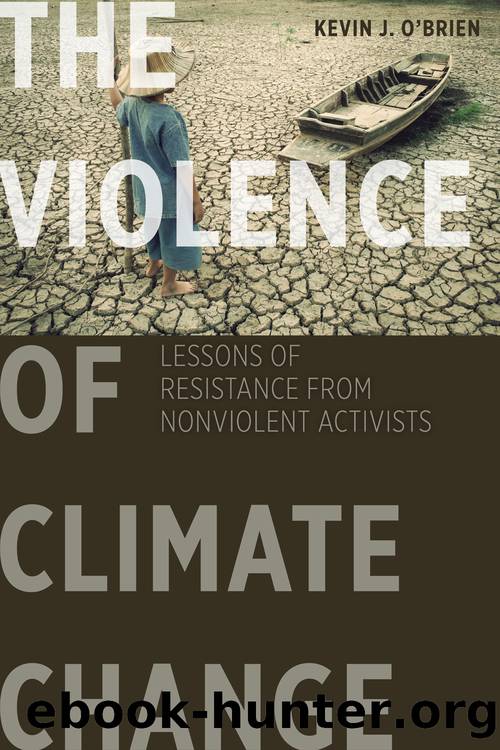The Violence of Climate Change by Kevin J. O'Brien

Author:Kevin J. O'Brien [O’Brien, Kevin J.]
Language: eng
Format: epub
ISBN: 9781626164352
Publisher: Georgetown University Press
Published: 2017-02-15T00:00:00+00:00
NOTES
For biographies of Jane Addams, see especially Elshtain, Dream of American Democracy; Brown, Education of Jane Addams; and Knight, Jane Addams. For analyses of Addamsâs thought and importance, see especially Fischer, Nackenoff, and Chmielewski, Jane Addams and Democracy; Hamington, Social Philosophy of Jane Addams; and Schneiderhan, Size of Othersâ Burdens.
1.On the practical work and politics of the âgarbage wars,â see especially Knight, âGarbage and Democracy.â
2.Addams, Democracy and Social Ethics, 120.
3.Addams, Twenty Years at Hull-House, 77â78.
4.Knight, Citizen, 190. How deeply Addams held her faith is a matter of some scholarly debate. It seems safe to say, however, that Addamsâs religious beliefs and practices, like everything else about her, continued to develop over the course of her life. Though she rarely discussed her own faith and had relatively low attachment to the Presbyterian Church or any particular congregation, she never publicly distanced herself from Christianity, and she used Christian ideals and concepts throughout her public career. See especially Stebner, âTheology of Jane Addamsâ; and Brown, âSermon of the Deed,â 21â39.
5.Addams, Jane Addams Reader, 25â26; also see 17.
6.Addams, Second Twenty Years at Hull-House, 404.
7.Addams, Twenty Years At Hull House, 175.
8.Ibid., 82. On this aspect of Addamsâs education, see Brown, Education of Jane Addams, chap. 13.
9.See especially Elshtain, Dream of American Democracy. Addams did help to raise a niece and nephew after their mother died, and she had many important relationships with many other children. Though she never married, she had a lifelong romantic friendship with Mary Rozet Smith, a Hull House supporter. See Knight, âLove on Halsted Street,â 181â200.
10.Addams, Newer Ideals, 5.
11.Addams, Writings on Peace, 285. For more analysis of Addamsâs ideas about peace as an evolutionary possibility, see especially Green, âLessons from Jane Addams,â 223â54.
12.Addams, Democracy and Social Ethics, xi.
13.Addams, Twenty Years at Hull House, 75.
14.Ibid., 206. See also Charlene Haddock Seigfried, âIntroduction,â in Democracy and Social Ethics, by Addams; and Fischer, On Addams, chap. 2.
15.Addams, Jane Addams Reader, 62.
16.Addams, Democracy and Social Ethics, 7, 117.
17.Ibid., 93. Interestingly, she made the same argument about child labor in chapter 5 of The Spirit of Youth and the City Streets. This chapter exemplifies Addamsâs pragmatism; she almost certainly would have preferred that fourteen-year-old children be in school rather than in factories, but she knew that the practical realities of many poor families required that even young children work. She acknowledged this reality and insisted that, for example, a child in a sewing factory be taught that âthe design she is elaborating in its historic relation to art and decoration if she understands âher daily life is lifted from the drudgery to one of self-conscious activity, and her pleasure and intelligence is registered in her product.â Addams, Spirit of Youth, 122.
18.Addams, Newer Ideals, 79. Addams also made the connection between her neighborhood and international conflict in The Second Twenty Years at Hull House, which argued that her settlementâs story could not be told apart from the story of World War II: âIt is idle to speculate on what an infinitesimal unit like Hull-House or any
Download
This site does not store any files on its server. We only index and link to content provided by other sites. Please contact the content providers to delete copyright contents if any and email us, we'll remove relevant links or contents immediately.
The Lonely City by Olivia Laing(4568)
Animal Frequency by Melissa Alvarez(4148)
All Creatures Great and Small by James Herriot(3986)
Walking by Henry David Thoreau(3681)
Exit West by Mohsin Hamid(3634)
Origin Story: A Big History of Everything by David Christian(3472)
COSMOS by Carl Sagan(3346)
How to Read Water: Clues and Patterns from Puddles to the Sea (Natural Navigation) by Tristan Gooley(3239)
Hedgerow by John Wright(3106)
How to Do Nothing by Jenny Odell(3101)
The Inner Life of Animals by Peter Wohlleben(3099)
How to Read Nature by Tristan Gooley(3077)
Project Animal Farm: An Accidental Journey into the Secret World of Farming and the Truth About Our Food by Sonia Faruqi(3018)
Origin Story by David Christian(2991)
Water by Ian Miller(2950)
A Forest Journey by John Perlin(2915)
The Plant Messiah by Carlos Magdalena(2745)
A Wilder Time by William E. Glassley(2689)
Forests: A Very Short Introduction by Jaboury Ghazoul(2671)
